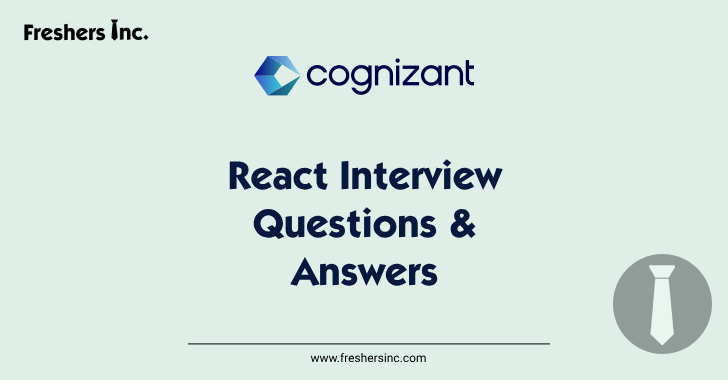Below Listed Cognizant React Interview Questions and Answers
Cognizant React Interview Questions and Answers. There React, a JavaScript open-source library with open-source code is widely used to build simple, fast, and scalable web applications. React was created by a software engineer named Jordan Walke who was working in Facebook at that time. React is built for web applications which makes it easy for developers that are familiar with Javascript to develop inside and out of React.
Here 20 Cognizant React Interview Questions in this article we have compiled the Interview Questions of React from basic to advanced React concept such as Virtual DOM, Components, State and Pros, JSX, Hooks, Routing and many more. These are collected from various trusted sources who has recently faced CTS technical Interview.

What is ReactJS?
ReactJS is a JavaScript library for constructing re-usable components for view layer in MVC architecture. This framework is utilized to construct the Single Page Application (SPA) because of its component-based architecture, the Virtual DOM that provides for a good re-rendering of the application, and for managing dynamic content without requiring a complete page reload. It is written in JSX.
Important Features of React:
Virtual DOM: React virtual DOM is being used to make updates of components and rendering increases performance as react batch renders and manipulates the real DOM.
Component-Based Architecture: React uses encapsulated components to build UI, making the code more scalable, maintainable, and functional.
Hooks — introduction of React Hooks extends functional components to safely manage state and side effect term that makes them feel easier and better.
Server-Side Rendering (SSR): React can also be used for server-side rendering, where HTML content can be generated server-side and sent to the client. This enhances the performance of the application, especially for the SEO.
React Router: React Router is used to navigate between value in react app. It enables you to configure a specific route for your desired view in the single-page application (SPA).
Explain the MVC architecture.
The Model-View-Controller (MVC) is architectural/design pattern that splits an application into three main logical components: Model, View, and Controller. Each component of the architecture is designed to work on a particular aspect of development regarding the application. It decouples the business, logic and presentation layers
React building blocks:
React consists of five main building blocks
- Components: They are a piece of reusable code that return some HTML.
- JSX: JSX stands for JavaScript and XML, it means that, in React, you can write the HTML.
- Props and State: props are similar to function parameters while State is similar to variables.
- Context: This enables data to be passed through the component tree as props at any level.
- Virtual DOM — A DOM Virtual copy that helps us to manipulate the DOM Versions.
What is virtual DOM in React?
React uses the idea of a Virtual DOM which is a memory-resident representation of the actual DOM. It uses diffing between the current and previous virtual DOM states to efficiently update and render the user interface.
How Virtual DOM Works?
Super Fast Rendering: The Virtual DOM is a representation of the actual DOM which set us free from the bottleneck process of UIs update and rendering.
Diffing Algorithm: React has a built-in algorithm that compares the previous and current versions of the Virtual DOM, it compares both of the DOMs, and find the least number of changes required to update the real DOM.
Batch Updates — React batch updates instead of updating the real DOM with every change made, thus avoiding unnecessary and workflow disrupting re-renders.
Faster Updates — Directly modifying the real DOM is also very slow, so React does not make these operations on the real DOM, it just updates the necessary parts of the real DOM and for that, It Use Virtual DOM and compares the Virtual DOM and for that, it uses Virtual DOM.
Declarative UI: Thanks to Virtual DOM, React lets developers write code in a declarative manner, while React takes care of when and how to efficiently update the UI.
What is JSX?
JSX is just a syntactic sugar for normal JavaScript which allows us to create React elements. These elements are finally displayed on the React DOM. React components were all written in JSX. When embedding any JavaScript expression within a block of JSX, it will need to be wrapped with curly braces {}
JSX: Name Inside Curly Braces { JSX }
const name = "Learner";
const element = (
Hello,
{name}. Welcome to FreshersInc.Com.
);
Components are nothing but just functions in React and each component is considered as a type.
One of the fundamental ingredients of React is a Component. Simply put: Every React App you create will consist of components. Now, the use of components makes the process of building UIs very easy.
We have primarily two types of components in React.
Functional: Functional Components are just plain JavaScript functions. A JavaScript function can be written to use a functional component in React.
Class Components: The class components are more complicated than the functional components. The functional components do not know of the other components in your program and the class component can use one another. We are able to transfer data from one class component to another class component.
How do browsers read JSX?
Generally, browsers are not able to read JSX and can only read JS code. JSX can be read by web browsers using a transpiler. JSX needs to be converted into JavaScript, and we use transpilers for that. Transpiling use Babel as a transpiler.
Just to note: it looks like you meant to ask how to print Hello World in a react application released until October 2023.
Before installing React, you should have Node installed on your computer. After installing Node. Now you have to open the terminal and run the commands given below.
Run this command npm create react-app >
Navigate to the folder.
cd >
The first Hello World of ReactJS code!!
import React from "react";
import "./App.css";
function App() {
return
Hello World!
;
}
export default App;
What is a key in React?
When we create lists of elements in React, we must provide a special string attribute called a key. In React, keys are a special string attribute you have to include when creating lists of elements. Keys help identify which items have changed, are added, or are removed. To put it another way, keys are used to identify the elements present in the lists.
What is the way to create a comment in React?
In React, we can comment in 2 Ways.
Multi-line comment: We can use multi-line comments in react using format with Asterisk /* /.
/
This is a multi-line comment.
It can span multiple lines.
*/
Single line comment: In React we can create single comments with // character.
This is a one-line comment
How do we use render method in React?
The React has a render() function that will render the HTML to the web page. Well, the function is used to render the HTML → code in the HTML element →. The render() method allows us to read props and state, and return our JSX code, to our app root component.
What is state in React?
State is an object of a set of observable properties that govern the behavior of a React Component Class; it is an instance of React Component Class. It simply means the State of a particular component is an object which has some information that can be dynamic over the lifetime of the component.
Explain props in React?
React provides a way to pass data to a Component via props (which stands for properties). Props are simply objects which can be passed to a component
We can access any props in the component’s class where you pass the props. You can then have access to the props like so:
this.props.propName;
What is Higher Order Component in react higher-order-component
HOC or higher-order component is advanced way of reusing the component functionality logic. Not more than that, it just accept the original component then return the component with added features. HOC are useful because it involves a simple code and is readable. Also, helps to avoid carrying similar logic in every component.
What is one way data binding in react?
Data-binding in ReactJS is one-way data binding, (Component to View, View to Component). We also called it one-way data flow data has one, and only one way to be passed to other parts of the application. Essentially, this means that the data passed into a child component from its parent component cannot be modified from within the child component. Easy to debug & less error prone
What is Context API in React?
The Context API — It allows sharing data (like theme, language preference etc.) between components without having to specify as props passed by the parent at every level It comes with a Provider component to provide the value and a Consumer component or useContext() hook to consume it.
What does shouldComponentUpdate() do in React?
shouldComponentUpdate() The quintessential lifecycle method, shouldComponentUpdate() simply tells a component if it should re-render or not upon receiving new props or state. If it returns false, React will stop the re-rendering process of this component.
What do you mean by dangerouslySetInnerHTML?
dangerouslySetInnerHTML :It is an attribute that can be used to set the html as is inside a component. It is better to avoid it as it will expose the app to XSS (cross-site scripting) but at times it can be used to render 3rd party HTML content.
React Pure Components- What Are They?
Pure Components are React components that only render if there is a change in their props or state. React provides React. PureComponent: a base class that shallow compares props and state by default to avoid re-rendering.
Why setState is Important Inside React?
setState is a function to set a component state. React will re-render the component and its children, so the components reflect the updates when the state gets updated.

